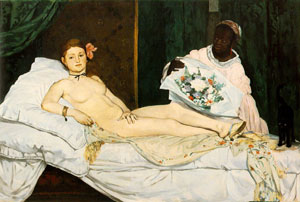Ever since she burst onto the scene in 1994’s Winter of Love show at P.S. 1, Italian-born artist Vanessa Beecroft has captivated the art world with her installations/performances of (mostly) scantily-clad, stiletto-wearing women.
It’s remarkable actually that Beecroft’s work has intrigued us for so long. After all, the list of what her projects have in common with each other is longer than the list of their differences. The venues, models, and costumes may all change, but the form and content have remained similar enough to become a bona fide trademark.
So if upon seeing Beecroft’s latest project for the first time you didn’t say it out loud (as a friend of mine did at the opening reception), you probably thought to yourself (with just a hint of disappointment): “I was expecting a room full of naked women….” Nor was it a video or even photographs of a room full of naked women, which is really how most of us know Beecroft’s work anyway. What we found instead was a two-sided video projection, each side depicting a black-and-white striped young woman reclining on a black-and-white striped sofa-bed within a black-and-white striped interior. To complete the picture, one of the women is white, the other black. Entitled Ponti Sister, the piece is named for the designer of the sofa-bed and the re-created interior, Italian legend Gio Ponti. Related to a project that she presented at last year’s Venice Biennale called the Sister Project, Beecroft has said that both pieces were inspired by Antonio Canova’s sculpture of Paolina Borghese, a half-nude reclining marble of Napoleon Bonaparte’s sister. The reference belies the artist’s classical training and suggests a connection not just with the Canova, but with the long history of reclining female nudes: Titian’s Venus of Urbino, David’s Madame Recamier, Ingres” Odalisque, and Manet’s Olympia.

the black Ponti Sister (scanned from the invitation: ...by the time we actually get to this shot in the video, ...~20 minutes along, the makeup starts smudging delightfully)
What is similar to Beecroft’s more familiar projects is the fact that not much happens in Ponti Sister. Each ‘sister” reclines on her bed, cycling through a number of poses, some reminiscent of the portraits previously mentioned. Each projection offers two perspectives on the same scene, each lasting approximately 30 minutes. The first perspective is from the corner of the room, that of an audience member at the live performance watching the art from a safe distance. Then suddenly the perspective changes to a full-frontal, life-size image of the model. Beyond those camera shifts, what “action” there is is limited to the models adjusting their positions, and the closest thing to “drama” comes when the camera angle suddenly reverts to the original perspective and the cycle begins anew. Once again the viewer is left to wonder what it’s all about. And that’s where Beecroft’s work gets interesting.
There’s no shortage of theories amongst the vast bibliography that has accumulated since the P.S.1 show back in 1994. There’s the post-feminist-critique about empowerment, and the one that criticizes Beecroft for objectifying women. Some see her work as a post-consumer commentary on fashion and the advertising industry, or a postmodern commentary on bourgeois ennui, or one on how both have made sex boring. There are the art historical arguments already mentioned and there’s the one that simply says it’s Hooters for intellectuals. One of the most insightful arguments compares Beecroft’s work to that of John Cage, arguing that both artists draw our attention to the moments of accident and happenstance that occur when seemingly nothing is going on.
There’s the chaos theory, for lack of a better name, that argues that the fidgeting, stretching, yawning, wandering models demonstrate the universe’s tendency towards disorder. The Ponti Sister models adjust themselves, their painted bodies smear on the sofa-bed, and their initial upright poses slowly deflate into a supine position. As we watch, what is at first a kind of pictorial flawlessness comes apart as all the elements collapse under the burden of perfection. What begins as a homogenized scene in which Beecroft one-ups Ponti, striping even the occupants and creating a kind of camouflage for the Wallpaper* jet set, ends up smudged and flat on its back.
Is it the tedium of sitting for the artist’s gaze as the model is drawn, painted, photographed, or videoed? We can see that “are we done yet” look in the Ponti Sister models” eyes. In his introduction to the Beecroft monograph VB 08-36, Dave Hickey talks about Beecroft’s fascination with the draftsman’s gaze, discovered in drawing class when the artist found herself more interested in watching the model than in making any drawings. Hickey quotes Victorian art critic John Ruskin to identify this gaze as “innocent.” Perhaps the artist is inviting us into the studio to partake in the joys of watching her models. Or there is the old argument of the gaze as instrument of power. The open question that has been widely discussed is whether Beecroft’s work inverts the traditional relationship between viewer and viewed: are these models presented for our visual delectation? Do they resemble the stereotypes of eroticism? We begin by gazing upon them from afar; but without warning we are suddenly confronted by their gaze, our privileged distance stripped away. It’s as though we’ve been caught staring, and we may momentarily feel the same discomfort that visitors to the Salon felt when first confronted with Manet’s Olympia. But Beecroft ups the ante: Ponti Sister breathes, blinks, and moves.

Ponti Sister adds it’s own list of interpretive possibilities to the Beecroft bibliography. To an American audience especially, the black-and-white format of the piece suggests racial overtones. What are the differences between us when we’re all black and white? Would we still find ways to segregate one group from another? I was reminded of the old Star Trek episode with the two aliens from the planet Cheron. As one of them said by way of explanation for their mutual hatred: “Can”t you see, Captain? He is black on the left side and white on the right while I am clearly white on the left side and black on the right.” Would it change your opinion if you were told that the two models, one of whom is Beecroft’s sister reprising her role from the Sister Project, are best friends?
But after all of that you may still think that there’s just not much going in Beecroft’s performances or their artifacts. You may dismiss all the theorizing as pretentious and this particular video as simply dull. But Ponti Sister is not a movie. It is not meant to tell a story in the narrative sense. It is instead much like the neoclassical marbles and paintings mentioned previously: a portrait of reclining nudes. The choice of how much time to spend with any of these artworks remains ours. We’re not required to sit through the entirety of Ponti Sister just as we’re not required to contemplate a painting or sculpture for a predetermined duration. We’d never complain that Paolina Borghese or Madame Recamier never did anything, that nothing much happens with Ingres’ Odalisque. What happens is not the point. What is suggested is where all art gets interesting. And so all these theories that abound in the writing about Beecroft’s art imply the many possibilities that it holds. Therein lies the true strength of her work: its openness to interpretation, its refusal to be any one thing. We’re told that the best art holds a mirror up to its audience. Vanessa Beecroft succeeds in holding up that mirror. Insert your idea here.
Images courtesy the artist and Lawing Gallery.
Chris Ballou is a writer, curator, and KTRU DJ working in Houston.





